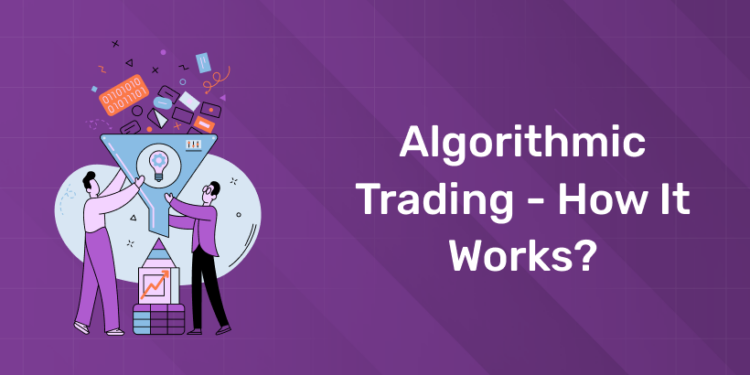Table of Contents
Algorithmic trading uses computer programs to execute trades based on predefined criteria. It automates trading processes, making them faster and more efficient. Algorithms analyze market data, identify opportunities, and execute trades at optimal times. This reduces human error and exploits market inefficiencies. Let us further understand Algorithmic Trading – How it works?
Join the Entri App Stock market course !
Algorithmic Trading – How it works?
What is Algorithmic Trading?
Algorithmic trading uses computer programs to execute trades automatically. Algorithms follow specific trading strategies based on market data. They analyze real-time and historical data to identify opportunities. Trades are executed quickly and efficiently by the computer programs. This reduces human error and transaction costs. The goal is to maximize profits and exploit market inefficiencies. Algorithmic trading requires finance, statistics, and programming knowledge.
How Does it Work?
Algorithmic trading uses computer algorithms to automate trading decisions. Algorithms follow specific trading strategies. They analyze real-time and historical market data for opportunities. When a signal is detected, the algorithm places orders automatically. Order Management Systems ensure orders are executed correctly. Algorithms include risk management rules to minimize losses. This process reduces human error and transaction costs. It maximizes profits by exploiting market inefficiencies.
Pros and Cons of Algorithmic Trading
Pros:
- Speed and Efficiency:
- Quick Execution: Trades are executed in milliseconds.
- High Frequency: Thousands of trades can be placed per second.
- Reduced Transaction Costs:
- Lower Costs: Less manual intervention reduces operational costs.
- Minimized Market Impact: Large orders are broken into smaller ones.
- Accuracy and Consistency:
- Precision: Algorithms follow exact rules without deviation.
- No Human Error: Automated systems avoid mistakes due to fatigue or emotions.
- Backtesting:
- Historical Data: Strategies are tested on past data.
- Strategy Refinement: Improves and validates strategies before live use.
- Market Efficiency:
- Liquidity: Market-making algorithms provide liquidity.
- Arbitrage: Algorithms exploit price differences, stabilizing prices.
Cons:
- Market Risk:
- Sudden Changes: Rapid market movements can cause losses.
- Flash Crashes: High-speed trading can increase market volatility.
- Technical Failures:
- Software Bugs: Errors in code can lead to unexpected trades.
- System Failures: Hardware or network issues can disrupt trading.
- Over-Optimization:
- Curve Fitting: Over-tweaking to fit past data may hurt future performance.
- Adaptability Issues: Over-optimized algorithms may struggle with new conditions.
- Regulatory and Compliance Risks:
- Adherence to Regulations: Necessary to avoid legal issues.
- Compliance Costs: Maintaining standards can be expensive.
- Ethical Concerns:
- Market Manipulation: Some algorithms may engage in unethical practices.
- Job Displacement: Automation can lead to job losses in trading fields.
Join the Entri App Stock market course !
Algorithmic Trading Strategies
Trend Following:
This strategy identifies and follows prevailing market trends. Algorithms buy assets in an uptrend and sell in a downtrend. They use moving averages or momentum indicators to make decisions. The idea is to profit from sustained market movements. It assumes trends persist over time.
Mean Reversion:
Mean reversion strategies bet that asset prices will return to their historical averages. Algorithms identify when prices deviate significantly from the mean and trade accordingly. They use statistical measures to detect overbought or oversold conditions. This strategy relies on price fluctuations reverting to the norm. It’s effective in range-bound markets.
Arbitrage:
Arbitrage exploits price discrepancies of the same asset in different markets or forms. Algorithms buy low in one market and sell high in another. This strategy aims for risk-free profits from price differences. It requires fast execution and low transaction costs. It’s based on market inefficiencies.
Market Making:
Market making involves providing liquidity by quoting buy and sell prices for an asset. Algorithms continuously adjust prices to balance supply and demand. They earn from the bid-ask spread between buying and selling prices. This strategy benefits from high trading volumes and narrow spreads. It stabilizes markets by facilitating trades.
Statistical Arbitrage:
This strategy uses statistical models to identify and exploit price inefficiencies between related assets. Algorithms analyze historical price relationships and trade based on predicted movements. It involves high-frequency trading and complex quantitative models. The goal is to capitalize on short-term mispricings. It requires rigorous data analysis and fast execution.
High-Frequency Trading (HFT):
HFT involves executing a large number of orders at extremely high speeds. Algorithms take advantage of small price changes and market inefficiencies. They rely on low latency and high-speed infrastructure. This strategy can generate profits from tiny price fluctuations. It’s characterized by rapid trades and high turnover.
Sentiment Analysis:
This strategy uses natural language processing to gauge market sentiment from news and social media. Algorithms analyze text data to predict price movements based on public sentiment. They trade based on perceived market mood or reactions. This strategy adapts to changing market dynamics and news events. It integrates alternative data sources for decision-making.
How to Get Started?
1: What is a stock?
Learn the Basics:
Understand financial markets and trading strategies. Familiarize yourself with key terminology and instruments. This foundational knowledge is essential for effective algorithmic trading.
Acquire Programming Skills:
Learn languages like Python or R for algorithm development. Python is popular due to its simplicity and rich libraries. Programming skills are crucial for coding and testing algorithms.
Study Quantitative Analysis:
Gain expertise in statistics and quantitative analysis. Learn about data analysis, statistical testing, and machine learning. These skills help in developing and refining trading strategies.
Choose a Trading Platform:
Select a platform or broker with algorithmic trading support. Ensure it offers API access for implementation. A suitable platform facilitates efficient trading and testing.
Develop Algorithms:
Create and test trading algorithms, starting with simple strategies. Backtest using historical data to evaluate performance. Iteratively refine your algorithms based on test results.
Paper Trading:
Test your algorithms in a simulated environment without risking real money. This helps identify issues and refine strategies safely. Paper trading is a crucial step before live trading.
Risk Management:
Implement risk management techniques like position limits and stop-loss orders. Protect your capital from significant losses. Effective risk management is essential for long-term trading success.
Monitor and Optimize:
Continuously track your algorithms’ performance and make necessary adjustments. Analyze performance data to identify improvements. Regular optimization helps maintain effectiveness in changing markets.
Stay Informed:
Keep up with market news and technological developments. Staying informed helps you adapt your strategies and remain competitive. Market conditions and technologies evolve, impacting trading outcomes.
Legal and Compliance:
Understand regulatory requirements for algorithmic trading in your area. Ensure your trading practices comply with legal standards. Adhering to regulations prevents legal issues and promotes fair trading.
Algorithmic Trading – How it works?: Conclusion
Algorithmic trading leverages sophisticated algorithms to automate trading decisions and executions. It requires a blend of finance knowledge, statistical analysis, and computer programming. While it offers numerous advantages in terms of speed and efficiency, it also presents challenges that need careful management.
Frequently Asked Questions
What is algorithmic trading?
- It uses computer programs to trade automatically based on set rules.
- Programs follow criteria like price and timing to make trades.
- It works faster than human traders.
How do algorithms know when to trade?
- They use math and past data to predict price changes.
- Algorithms follow specific trading strategies.
- They execute trades based on these predictions.
What are the main parts of an algorithmic trading system?
- Key parts are market data, trading programs, order execution, and risk management.
- Market data gives real-time information.
- Trading programs decide when and what to trade.
How do algorithms ensure good trade execution?
- They find the best prices for trades using smart routing.
- They split large orders to reduce market impact.
- Algorithms adjust trades in real-time based on market conditions.
What are the risks of algorithmic trading?
- Risks include technical failures, errors in the program, and market changes.
- Poorly tested algorithms can lead to big losses.
- It’s important to follow regulations to avoid legal issues.












